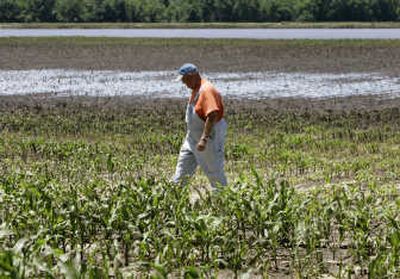Midwest flood damage may push food prices higher

The flood tides enveloping the Midwest will crest across the nation in the form of higher prices in just the places where households have been hit the hardest – food and fuel.
Floodwaters have spread across the Corn Belt, preventing farmers from planting soybeans and damaging a corn crop just starting to emerge from the ground. Analysts now estimate that flooded Iowa and Illinois and the other corn states might produce 15 percent less of the grain than last year. Some believe the shortfall will be larger.
That pushed corn prices to near $8 a bushel Monday and sparked fears of another spike in food inflation. Already, food inflation is increasing at its fastest pace in 18 years.
“This is a pretty big train wreck developing,” said Steve Meyer of Paragon Economics in Adel, Iowa.
Corn is one of the economy’s critical commodities. It feeds cattle and dairy cows, it’s cooked into breakfast cereal, it sweetens soda pop and creates ethanol. The developing shortage is expected to increase competition for corn among farmers, food companies, ethanol refiners and exporters.
Consumers can expect “to pay more at the pump or more in the food aisle, or both,” said Chat Hart, an agricultural economist at Iowa State University.
For now, cattle ranchers, pork farmers, dairies and other food producers will take the largest hit, said Michael Swanson, a Wells Fargo & Co. agricultural economist.
“We have record prices for hogs and for cattle, but these prices aren’t going to be high enough for the farmers to make any money because the price of corn is so high,” he said.
Barring a sudden turnaround in the corn markets, shoppers should expect to see the price of meat rise as farmers reduce their herds’ size to save money on feed.
Some economists believe that will create a short-term dip in meat prices followed by increases. Meyer, who specializes in the economics of the U.S. livestock market, expects prices will remain steady for some months but not decline. He said chicken prices will start to increase first, as poultry supplies tighten. That will be followed by pork and then beef.
Hog farmers in South Dakota are starting to liquidate their herds and exit the business, said Jeremy Lehrman, executive director of the South Dakota Pork Producers Council.
The pork industry is dependent on farmers such as Doug Boland, 53, a fourth-generation farmer who lives near Williamsburg, Iowa, about 35 miles southwest of flood-ravaged Cedar Rapids.
Much of the 100 acres Boland farms runs along the English River, which has flooded twice this year and stymied his efforts to get plants in the ground.
He spent Monday combing his property for small lots, dry enough to plant soybeans. He found 3 acres in one corner, 12 in another section and altogether can plant on 35 acres, but he’s not sure if the plants will take hold.
“We should have corn right now, all across this land that is knee high. It should be rich and green,” Boland said. But as he looked at the neighboring farms, all Boland could see was wet, straggly yellowing corn shoots, barely inches above the ground. “I am not sure how much yield we are going to get out of any of this.”
Earlier this month, the USDA estimated a demand for 12.5 billion bushels of corn in the coming year. About 5 billion would be used for feed, another 4 billion consumed by ethanol production, 2 billion sold overseas and the rest used for other food, seed and industry. The nation was on schedule to produce just 11.7 billion. The shortfall would be made up by corn grown in previous years and stored.
But because of the soggy plants across the Midwest, analysts think corn production could fall to around 11 billion bushels, draining supplies to precariously low levels.
“Everyone is going to have to cut back,” Meyer said.
Some analysts believe the rapid increase in the use of corn to make ethanol has left little room to maneuver through weather-related disasters.
“Our ethanol policy requires perfect weather, and not surprisingly, we aren’t getting it,” said Michelle Perez, senior agriculture analyst with the Environmental Working Group in Washington, D.C.
Perez said that in establishing the federal mandates for the use of renewable fuels, the Bush administration and Congress have ignored “the impact this policy could have on food prices, relying entirely on good weather to make this roll-of-the dice decision a success.”
Even before the latest rains, the amount of acres devoted to corn was falling.
Enticed by high prices for soy and wheat, farmers expected to plant 86 million acres this year, about 8 percent less than 2007, according to the USDA.
Dan Lundberg has struggled to get his crop into the ground because of the wet spring.
He lives in Hull, Ill., a Mississippi River town (pop. 350) swamped in 1993 – and the waters are rising now. Most of his farmland has been far too wet to plant crops. What has taken root is tiny and growing sluggishly.
“I’ve got 500 acres I still can’t get into yet, and it’s already June,” Lundberg said. “I’m going to have to leave it untilled and unplanted this year, and that is going to kill our family’s savings this year.”
The floods also have disrupted the movement of goods across the heartland, and roads and rail lines become submerged. Union Pacific Corp. has closed certain parts of its east-west main line across Iowa. Cresting flood waters in nearby states have limited the railway’s ability to reroute cargo. Union Pacific won’t see the full extent of the damage to its rails until the water recedes.
The storms have hit Iowa hard. Officials have declared 83 of its 99 counties disaster areas, and tens of thousands have been evacuated from their homes.